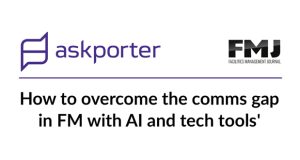 Rob Norton, UK Director at PlanRadar argues that traditional recordkeeping practices in construction are causing FMs operational headaches
Rob Norton, UK Director at PlanRadar argues that traditional recordkeeping practices in construction are causing FMs operational headaches
Around the world, the construction industry is haemorrhaging money. RIBA’s comprehensive review highlights the shocking reality that every year billions of dollars are lost annually to avoidable disputes. Frequently, poor documentation sits at the heart of this crisis, with facilities managers bearing the long-term consequences of these failures.
Far too often, FMs are left managing buildings with incomplete records, missing certifications and gaps in compliance documentation that create ongoing operational headaches and regulatory risks, given the construction industry’s tendency to litigate.
PAPER TRAIL PROBLEM
Traditional paper-based documentation systems aren’t just ‘old school’ and inefficient; they’re potentially hazardous. When fire door installations lack proper certification records, when inspection reports go missing during handovers, when compliance documentation exists only in filing cabinets scattered across multiple offices, then facilities managers face an almost impossible task.
Post-Grenfell, the regulatory environment has fundamentally shifted, with scrutiny around documentation and compliance more intense than ever. Now that The Building Safety Act is in force, excuses such as “we can’t find the paperwork” are no longer considered acceptable responses by auditors or safety inspectors.
Despite this heightened regulatory pressure, the construction industry continues to rely on 20th century documentation methods. The upshot? A perfect storm of financial losses, compliance failures and safety risks that FMs are left to navigate.
COST OF DOCUMENTATION FAILURES
The financial implications of poor documentation extend throughout a building’s entire lifecycle. When proper handover documentation is missing, facilities managers spend countless hours reconstructing project histories, tracking down certifications and filling gaps in maintenance records. This isn’t just inconvenient and resource intensive, it’s expensive.
Consider the following scenario: a facilities manager discovers during a routine audit that fire door certifications are incomplete. Without proper digital records, establishing compliance becomes a costly exercise in detective work. Contractors must be recalled, inspections repeated, and certifications reissued, all at significant expense.
More critically, incomplete documentation creates liability exposure. When building safety incidents occur, investigators start asking questions about documentation; ‘Can you prove work was completed to specification?’, ‘Do you have traceable records of inspections and certifications?’. Without comprehensive digital documentation, these questions become legal nightmares.
DIGITAL DOCUMENTATION
Digital documentation represents more than technological convenience; it’s a transformation that creates a ‘single source of truth’ that can be referred to throughout a building’s lifecycle. This is about ensuring the kinds of accountability, traceability and transparency that traditional methods have too often failed to deliver.
Modern digital platforms provide FMs with unarguable records for every critical task. Fire door installations come with timestamped photographic evidence, inspector signatures and automatic compliance tracking. Maintenance schedules link directly to manufacturer specifications and regulatory requirements. Building modifications are documented with before-and-after evidence that satisfies rigorous audits.
The transformation extends beyond individual records to adhere to the “Golden Thread” of accountability; a complete, traceable record that follows every element of a building from initial design through construction and operation.
DIGITAL SOLUTIONS
Leading digital platforms can transform construction and facilities management documentation. By connecting entire project teams on unified platforms, these systems remove the information silos that afflict traditional approaches.
For facilities managers, the strength lies in a comprehensive approach to building lifecycle management. From initial construction through ongoing maintenance, every interaction with the building generates traceable, accessible records. Technical drawings, inspection reports, maintenance schedules and compliance certificates can all exist in one searchable, secure location.
A platform’s mobile-first approach means documentation happens in real-time, on-site. Contractors can’t simply “forget” to document work, the system requires completion before tasks can be marked as done. Photographs, measurements and certifications are captured automatically, creating comprehensive records without additional administrative burden.
Digital documentation prevents information loss during handovers. Instead of inheriting boxes of mixed paperwork and hoping for the best, FMs receive complete digital records with full search functionality and automatic compliance tracking.
THE URGENCY OF CHANGE
Building safety scrutiny will intensify as authorities grapple with legacy compliance issues and emerging safety challenges. Facilities managers who continue relying on traditional documentation methods are essentially gambling with both budgets and their careers.
The technology exists today to eliminate documentation-related disputes and compliance failures. Forward-thinking facilities managers across the industry are already embracing these solutions demonstrating that digital transformation in construction documentation is more than aspirational, it’s attainable here and now.
The choice facing facilities managers is clear: continue wrestling with inadequate documentation systems that create risk and consume precious resources, or embrace digital platforms that provide comprehensive, traceable records throughout the building lifecycle.
The construction industry’s billion-dollar documentation problem has a solution, digital documentation. It works. Now, the question is whether facilities managers will adopt it quickly enough to avoid the mounting costs of inaction.





